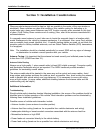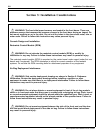
Installation Considerations 3-1
Section 3: Installation Considerations
Mobile Radio Installation Guidelines
NOTICE: This information has been prepared for use by persons installing 2-way radio
equipment (transmitters and receivers) in vehicles. It has been prepared in accordance with
current engineering principles and generally accepted practices, using the best information
available at the time of publication. These guidelines are intended to supplement, but not to
be used in place of detailed instructions for such installations which are the sole
responsibility of the manufacturer of the land mobile radio. Since it is not possible to cover
all possible installations of 2-way radio equipment, Ford Motor Company cannot be held
responsible for incidental or consequential damages arising from the use of the information
contained herein. Certain land mobile radios or the way in which they are installed may
affect the vehicle operations such as the performance of the engine and driver information,
entertainment and electrical charging systems. Expenses incurred to protect the vehicle
systems from any adverse effect of any such installation are not the responsibility of Ford
Motor Company.
General Information
Ford Motor Company vehicles are designed and tested for safe operation with correctly installed
and used land mobile/amateur radio communication equipment with up to 100 watt transmitter
power.
Special design considerations are incorporated into all Ford vehicle electronic systems to provide
immunity to radio frequency signals. To maintain compatibility with vehicle electronic systems,
mobile 2-way radio and telephone equipment must be installed correctly by trained personnel,
observing these general guidelines:
• Power connections should be made directly to the battery and fused as close to the battery as
possible. Avoid using cigar lighter or power point receptacles as power sources for radio
communication equipment.
• Antennas for 2-way radios should be mounted on the roof or the rear area of the vehicle. Care
should be used in mounting antennas with magnet bases, since magnets may affect the
accuracy or operation of the compass on vehicles, if so equipped.
• The antenna cable should be high quality, fully shielded coaxial cable, and kept as short as
practical. Avoid routing the antenna cable in parallel with vehicle wiring over long distances.
• Carefully match the antenna and cable to the radio to achieve a low standing wave ratio (SWR)
and to avoid radio frequency currents on the antenna cable shield.
All installations should be checked for possible interference between the communications
equipment and vehicle electronics. Mobile radio equipment with greater than 100 watts output may
require special precautionary measures beyond those outlined in this document.
This pamphlet is provided as a supplement to the radio manufacturer’s installation instructions for
installing communication equipment in Ford vehicles. Additional sources of information are listed
on page 3-4.
2010 Expedition SSV Modifiers Guide, 07/2009


















